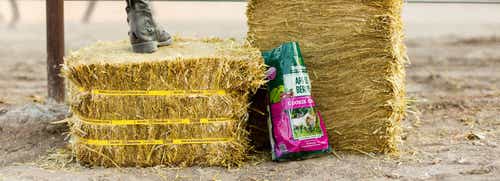
Consistent Nutrition and Forage Quality Defends Horses from Digestive Issues
The horse has evolved as a grazing animal and forage continues to play a pivotal role in equine health. Horses are non-ruminant herbivores, also known as “hindgut fermenters”. Their digestive tract is made up of a simple stomach, small intestine and large intestine. The natural feeding habit of the horse is to eat small amounts of roughages, often. Domestication brought a change to this. Modern horse management practices incorporate stabling, increased grain-based concentrate consumption, meal feeding and limited pasture access. These changes led to a myriad of problems by undermining the horses’ digestive capabilities.
To ensure optimal health, horses must be given access to a high-quality fiber-based diet. Grain concentrates and supplements should only be fed to compliment the forage offered. If high-quality forage is fed, most horses only require a low intake of a vitamin and mineral pellet (ration balancer pellet). As horses increase their workload or physiological demands, e.g., pregnancy or lactation, additional concentrate may be required. Standlee Premium Western Forage® Timothy provides consistent nutrition to maintain optimal gastrointestinal function and support digestive health. In third-party testing, Standlee Premium Timothy Grass had higher nutrient content compared to a locally sourced grass hay (Perron, et al., 2019). Feeding Standlee Premium Western Forage products (bagged forage or bales) will boost the quality, consistency and nutrient profile of marginal quality forage. This will help satisfy horses’ nutrient requirements and decrease the amount of grain needed.
Horses require an absolute minimum of 1% of their body weight in dry forage per day; for a 1000lb horse, this equates to 10lb per day. A safer guideline is to provide horses with a minimum of 1.5 to 2% of their body weight in dry forage per day (this equates to 15 to 20lbs of dry forage per day for a 1000lb horse). Some classes of horses cannot tolerate diets high in sugars and starches, for example, senior horses. Standlee Alfalfa or Teff Grass is an excellent choice for senior horses who may require diets lower in sugars and starches. Standlee provides premium, high-quality forage, in several varieties, to satisfy the nutritional needs of all classes of horses. Standlee Forage is grown in the Western United States and is without equal, in quality and nutrient profiles. Research shows Standlee Alfalfa and Timothy Grass provided a more consistent and appropriate profile of key nutrients than comparable locally sourced hays (Perron, et al., 2019; Stewart, et al., 2017).
There are several options available when adding high-quality western forages to your horse’s feed program. Bagged pellets, cubes or chopped forage products are easy to incorporate into your existing feeding program to improve the nutritional value of lesser quality hay. For instance, if you are currently feeding 1.5 to 2% of your horse’s body weight in lesser quality hay, improve the quality by replacing a portion of the hay ration with Standlee Forage pellets or cubes (be sure to replace on a pound for pound basis). Benefits to bagged forage products include guaranteed consistency in quality and nutritional profile, less waste and easier storage and handling than larger bales. Standlee also provides consistent, high-quality compressed bales for those preferring long-stemmed forage.
If you have questions, please contact the nutritionist at Standlee Premium Western Forage, or consult with your veterinarian.
By Dr. Tania Cubitt & Dr. Stephen Duren
Performance Horse Nutrition
Scientific References:
Perron, B.S. & Jacobs, Robert & Jerina, M.L. & Gordon, M.E. & Duren, S.. (2019). Comparative assessment of intake and consumer preference of Standlee Premium Western Forage Alfalfa hay versus a locally sourced alfalfa hay using objective attributes. Journal of Equine Veterinary Science. 76. 96-97. 10.1016/j.jevs.2019.03.136.
Perron, B.S. & Jacobs, Robert & Splan, Rebecca & Jerina, M.L. & Gordon, M.E. & Duren, S.. (2019). Glucose and insulin response to feeding Standlee Premium Western Forage Alfalfa hay versus a locally sourced alfalfa hay. Journal of Equine Veterinary Science. 76. 89. 10.1016/j.jevs.2019.03.119.
Stewart, R.L. & Jacobs, Robert & Jerina, M.L. & Duren, S. & Gordon, M.E.. (2017). A comparative assessment of Standlee Premium Western Forage Timothy Hay versus “standard” locally sourced hay based on consumer perspective. Journal of Equine Veterinary Science. 52. 98. 10.1016/j.jevs.2017.03.146.
Stewart, R.L. & Jacobs, Robert & Jerina, M.L. & Duren, S. & Gordon, M.E.. (2017). A comparative assessment of Standlee Premium Western Forage Timothy Hay versus locally sourced grass hay using nutrient composition, glucose and insulin response, and palatability. Journal of Equine Veterinary Science. 52. 77. 10.1016/j.jevs.2017.03.097.








